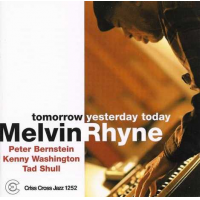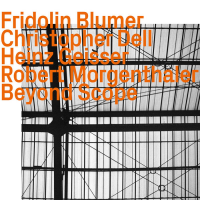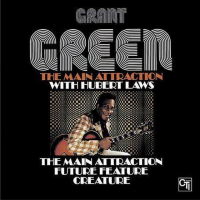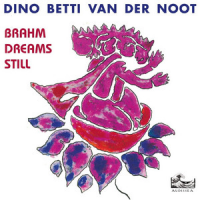Home » Jazz Articles » Liner Notes » David Hazeltine: Blues Quarters, Vol.2
David Hazeltine: Blues Quarters, Vol.2
It's also interesting to ponder the fact that Hazeltine, Alexander, bassist Peter Washington, and drummer Joe Farnsworth have all built very prosperous careers over the past several years and have done so in a manner that is somewhat left of center from the norm. Historically, jazz musicians have gained prominence either through the forging of completely new paths that can also hold traps for alienating an audience or by recreating former styles in a retro manner that puts originality at a lesser premium. But while Hazeltine and his cohorts have steered clear from avant-garde leanings, preferring to work squarely within the bop tradition, they have expanded upon and refined the constraints of the mainstream in a way that has led to revitalization of a style that threatened to stagnate during the "young lions" craze of the late '80s and early '90s.
One of the incubators for this new music has been the group One For All, a sextet of leaders including Hazeltine and his friends from the disc at hand, the collective just recently celebrating an unprecedented ten-year run that culminated in its recent album The Lineup being honored as Recording of the Month in the November 2006 issue of Stereophile magazine, a prize usually reserved for classical or other more obscure releases. In his review of the disc, Robert Conrad commented strongly on the "headlong plunging urgency" of the music that he avows would not be possible without the "world-class blue-collar rhythm section [including] Hazeltine and Farnsworth." The point being that it is this same chemistry and common sense of purpose that makes Blues Quarters Vol.2 such a satisfying recital.
Like the first set, this latest offering goes for a combination of original tunes and some well-picked standards, but with an additional twist. On several tracks, the Latin rhythms of conguero Jose Alexis Diaz provide further seasoning that is aided and abetted by Hazeltine's coy arrangements. A veteran of New York's Latin scene, Diaz has been heard with many giants of the music including Tito Puente and Mario Bauza and can also be found on At the Main Event (Criss 1070) by trumpeter Brian Lynch.
"Moment of Joy" gets things started on a sunny note, this easy-going swinger boasting an atypical form with eight bars of an opening theme followed by a twelve-bar release that is then repeated. Statements by Alexander and Hazeltine precede a short testimonial by Washington, who proves not only to be a confident supporting player throughout but also a highly musical soloist.
Diaz makes his first appearance on the smoldering "But Here's the Thing," an Afro-Cuban groove that is built around sections of varying length, although the solos stick closely to the basic 16-bar structure of the head. Eric leads off with a typically refined solo full of rhythmic variety and textural variations such as upper register shouts and cries. Hazeltine follows before turning things over to Diaz, who blows over a percolating vamp with Farnsworth's rim clicks marking the clave.
Eric Alexander contributes "Inner Circle," a medium tempo number with a basic 24-bar form. This time around, Hazeltine takes the first several choruses before handing it off to Alexander. The two then take turns trading four bar exchanges with Farnsworth, an especially musical drummer who can always be counted on for statements that rely more on cogent phrasing and rhythmic resourcefulness than on mere displays of technical flash.
An iconic number directly associated with the feel good music of the 1960s, "Goin' Out of My Head" first hit the pop charts as performed by Little Anthony and the Imperials. Later, guitarist Wes Montgomery would see its potential for jazz fodder in a 1965 version arranged by Oliver Nelson. Alexander sits out on this one, but Diaz is back to help establish a lightly swinging bossa beat. This is just one example of Hazeltine's expertise in updating pop tunes of the '60s and '70s, an area which lately seems to have become his specialty.
Often considered the perfect litmus test for determining a jazz musician's potential for interpreting a ballad, "Embraceable You" is also one of George and Ira Gershwin's best-known pieces, the 1944 gem making its debut in the film Girl Crazy. Alexander delivers the melody with an appropriate degree of warmth and immediacy before the pace quickens at the start of Hazeltine's first solo chorus. The tempo stays up for Alexander's entrance and soon he's using the opening phrase as a launching point for further development, his unaccompanied cadenza bringing things in for a smooth landing.
"Unforgettable" will always be closely associated with Nat King Cole, his original version peaking as high as #12 on the Billboard charts back in 1952. Subsequent performances would include those by pianist Dick Hyman and vocal great Dinah Washington, but neither of these pack quite the visceral punch of Hazeltine's sagacious reworking here. With Diaz again on congas, the pace quickens for a fine series of solos from Alexander, Hazeltine, and Diaz in that order.
Looking for a number in waltz tempo, the quartet settles on "Suddenly, It's Spring," a seldom-heard standard that nonetheless can be heard in several jazz incarnations by instrumentalists such as Zoot Sims and Stan Getz and by several vocalists including Frank Sinatra and Chris Connor. Farnsworth's Latinesque embellishments accompany an opening vamp that subsequently leads into Alexander's delivery of the melody, the overall mood not unlike that of McCoy Tyner's "Three Flowers."
The universality of the blues that also happens to give the disc its title makes it presence strongly felt on the concluding two numbers. ""Blues Quarters 2" and "Blues for Us," the former not technically a blues and the latter definitely of the 12-bar variety, both make the most of one of the music's oldest and more enduring forms with some fluent soloing from everyone on board.
Of course it goes without saying that jazz has continued to struggle to find its place within a market that has changed dramatically over the past few years. In many ways, the presentation of jazz recordings from a historical perspective is directly opposed to current technological favorites such as iPods and MP3s. Because of this, it's doubtful that many jazz fans are looking to cram as many "tunes" into their pods as they can. Hazeltine and his close circle of friends have the opportunity to turn the tables on this current state of affairs as they continue to make music of the highest caliber. Blues Quarters 2 joins an already impressive body of work that is sure to stand the test of time even as the times are rapidly changing.
Liner Notes copyright © 2026 C. Andrew Hovan.
Blues Quarters, Vol.2 can be purchased here.
Contact C. Andrew Hovan at All About Jazz.
An avid audiophile and music collector, Chris Hovan is a Cleveland-based writer / photographer / musician.
Track Listing
Moment Of Joy; But Here's The Thing ; Inner Circle; Goin' Out Of My Head; Embraceable You; Unforgettable; Suddenly It's Spring; The Second Blues Quarters; Blues For Us.
Personnel
David Hazeltine
pianoPeter Washington
bassJoe Farnsworth
drumsJose Alexis Diaz
percussionEric Alexander
saxophone, tenorAlbum information
Title: Blues Quarters, Vol.2 | Year Released: 2006 | Record Label: Criss Cross
Tags
PREVIOUS / NEXT
Support All About Jazz
 All About Jazz has been a pillar of jazz since 1995, championing it as an art form and, more importantly, supporting the musicians who make it. Our enduring commitment has made "AAJ" one of the most culturally important websites of its kind, read by hundreds of thousands of fans, musicians and industry figures every month.
All About Jazz has been a pillar of jazz since 1995, championing it as an art form and, more importantly, supporting the musicians who make it. Our enduring commitment has made "AAJ" one of the most culturally important websites of its kind, read by hundreds of thousands of fans, musicians and industry figures every month.























